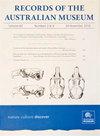澳大利亚东南部麻利龙蜥属一新种(鳞目:龙蜥科)
IF 0.8
4区 生物学
Q4 ZOOLOGY
引用次数: 4
摘要
对agamid lizard Ctenophorus fordi地理变异的研究支持了早期遗传研究中确定的区域谱系多样性模式,并为这些谱系的形态学诊断差异提供了新的信息。在这些谱系中,最具遗传差异和形态特征的是由澳大利亚东南部内陆红色沙原上的Triodia Mallee栖息地组成的种群。来自该地区的人口是所有其他“C”的姐妹血统。“fordi”是一套分布在澳大利亚南部干旱内陆的四个基因区域离散谱系。他们可以通过成年男性独特的黑色“T”形胸部图案来区分,结合身体比例和比例的某些特征,可以诊断出与所有其他“C”的血统。fordi”。根据这些差异的强度,我们将属于这个分支的种群描述为一个新物种,Ctenophorus spinodomus sp. 11 .这个新物种在它所占据的栖息地中受到高度限制,它的生态依赖于Triodia hummock grass groundcover (spinifex)的存在作为庇护所,觅食和社会互动。它似乎在燃烧后20-50年发育的广泛和健康的三叶草地区最为丰富,因此太多或太少的火灾都会对该物种的丘状草地被植物的适宜性产生负面影响。澳大利亚东南部的Mallee栖息地是碎片化的,在较小的孤立栖息地发生的大火可能导致该物种失去适合的栖息地,导致局部灭绝,没有机会重新繁殖。这些因素加上栖息地的持续丧失,使得剩余的棘足棘鼠种群处于高度脆弱的状态。本文章由计算机程序翻译,如有差异,请以英文原文为准。
Ctenophorus spinodomus sp. nov., a new species of dragon lizard (Squamata: Agamidae) from Triodia Mallee habitat of southeast Australia
Research into geographic variation in the agamid lizard Ctenophorus fordi supports a pattern of regional lineage diversity identified in earlier genetic studies, and provides new information on differences in morphology diagnostic of these lineages. One of the most genetically divergent and morphologically distinctive of these lineages is that consisting of populations from Triodia Mallee habitat of the red sandplains of inland southeast Australia. Populations from this region are the sister lineage to all other “C. fordi”, a suite of four genetically regionally discrete lineages distributed across the arid inland of southern Australia. They can be distinguished by a unique black “T” shaped chest pattern in adult males which, in combination with certain features of body proportions and scalation, diagnose the lineage from all other “C. fordi”. On the strength of these differences we describe populations belonging to this lineage as a new species, Ctenophorus spinodomus sp. nov. This new species is highly restricted in the habitat it occupies, and its ecology tied to a reliance on the presence of Triodia hummock grass groundcover (spinifex) for shelter, foraging and social interactions. It appears to be most abundant in areas of extensive and healthy Triodia that develop 20–50 years post-burn, and as a consequence too many or too few fires can both have negative impacts on the suitability of hummock grass groundcover for this species. Mallee habitat in southeast Australia is fragmented, and large fires in the smaller isolated areas of habitat could result in loss of suitable habitat for the species, resulting in localized extinction with no opportunity for recruitment. These factors in combination with ongoing loss of habitat place the remaining populations of C. spinodomus sp. nov. at a high level of vulnerability.
求助全文
通过发布文献求助,成功后即可免费获取论文全文。
去求助
来源期刊
CiteScore
0.90
自引率
0.00%
发文量
9
审稿时长
>12 weeks
期刊介绍:
Records of the Australian Museum, volume 62 was published in 2010, volume 63 in 2011. Monographic works of particular significance are published irregularly as Records of the Australian Museum, Supplements (ISSN 0812-7387).

 求助内容:
求助内容: 应助结果提醒方式:
应助结果提醒方式:


